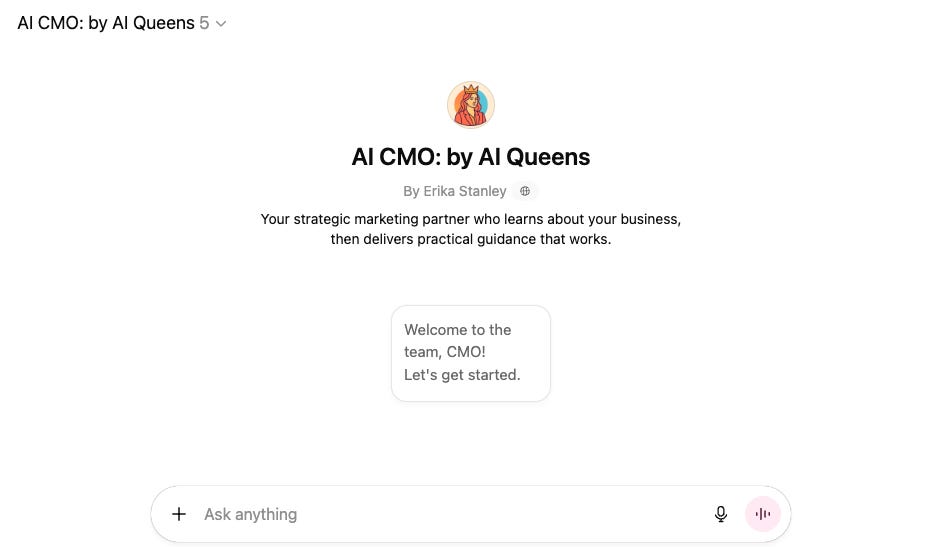The AI CMO framework I just shared with 10,000 marketers
This conversation with Michael Stelzner crystallized everything we’ve been building here at AI Queens.
You know how we’re always talking about using AI strategically instead of just asking it to write you things?
Well, yesterday I got to share that exact philosophy with Michael Stelzner’s audience on the AI Explored podcast. And our conversation crystallized something I’ve been thinking about for months.
We’re not just building better prompts here. We’re building AI systems that think strategically about our businesses.
(Remember this post? Our conversation builds on this…)
I walked Michael through my full AI CMO framework - the same process I’ve been refining with you all in the Ai Queens Society. But explaining it to his audience (smart marketers hearing this for the first time) helped me see just how revolutionary this approach really is.
What clicked during our conversation
Most people are stuck in “AI intern” mode. They ask ChatGPT to write a social post, Claude to brainstorm ideas, Gemini to help with emails.
But you? You’re ready for something bigger.
You’re ready to build an AI chief marketing officer that knows your brand voice, understands your business goals, and draws from the collective wisdom of every marketing expert you admire.
For $20/month instead of $150K.
The complete framework I shared (and you get the full breakdown)
1️⃣ Phase 1: Foundation - The Part Everyone Skips
This is where the magic actually happens, before you ever touch a tool.
✭ Document Your Brand (Beyond Logo and Colors)
Pull your bio, about page, anything you’ve written about yourself
Gather client testimonials - especially the ones where they rave about working with you
Include transcripts from happy client calls (goldmine of authentic voice)
Define your unique perspective: What’s your soapbox? Your hill to die on?
Create a word bank of phrases you use repeatedly (I always sign emails with “cheers”)
Pro tip I shared with Michael: If you have an AI assistant that records your meetings, you’re sitting on a voice goldmine. Feed those transcripts to ChatGPT and ask it to pull out common words and phrases you use when talking about things that light you up.
✭ Define Your Real Business Goals
Don’t start with “I want 10,000 Instagram followers.” Ask why. What’s that getting you? What’s the big picture?
Pull from:
Your business plan and vision statements
Those late-night Apple Notes where you dream about where you want to be in 3-5 years
Your actual revenue goals and what you need to hit them
✭ Choose Your Expert Influences
This is where it gets fun. If you had unlimited budget and could hire any marketing expert, who would you choose?
I told Michael: Maybe you want Seth Godin’s creative thinking, Rand Fishkin’s SEO knowledge, and Amy Porterfield’s marketing savvy all rolled into one CMO.
Here’s how you gather their expertise:
Find their blogs, podcasts, YouTube channels
Use deep research in ChatGPT or Claude to find their signature content pieces
Pull RSS feeds if available
Look for transcripts of their best interviews
You’re creating a reference library of the best marketing minds, customized to your specific goals.
TL;DR I created an AI CMO for you to use. Check it out 👇
2️⃣ Phase 2: Build Your System (Platform Breakdown)
I walked Michael through my messy journey across platforms:
Custom GPT (Start Here)
Easiest entry point
Put your brand info in the instructions
Upload your expert research to the knowledge base
You can tag it into any ChatGPT conversation with @YourCMOName
Claude Projects (My Current Favorite)
Same knowledge base as Custom GPT
But generates “artifacts” - separate documents for LinkedIn posts, blog posts, newsletter ideas
Better at strategic thinking and will actually challenge your ideas
Memory across conversations
Poppy AI (Advanced Level)
Visual interface like Miro or virtual whiteboards
Can pull TikToks, Instagram Reels, unlisted YouTube videos
You control which information connects to each conversation
Can switch between different AI models (Claude, ChatGPT, Gemini) in real-time
The key: Pick one platform and get good at it. I bounce between all three (don’t do what I do), but you’ll get better results focusing on one.
3️⃣ Phase 3: Put It to Work (Three Strategic Use Cases)
1. Analytics - Your Data Detective
I just finished season one of the AI Queens podcast and used my CMO to analyze everything:
Podcast download numbers and listen duration
Substack open rates and click-throughs
YouTube analytics and engagement
I uploaded all the data and asked: “What are my best-performing episodes? What do they have in common? What topics should I plan for season two?”
You can do this with:
Newsletter analytics (export as CSV)
Social media performance from Meta
Website traffic from Google Analytics
Any data you can screenshot or export
2. Advisory - Your Strategic Sparring Partner
This is where it gets powerful. Instead of asking for tasks, ask for strategy:
“You know my brand, my business goals, my growth trajectory. Here’s my revenue for the last six months, here’s where I want to be. What do I need to do over the next quarter to hit my year-end goals?”
Important caveat I shared with Michael: ChatGPT loves to be agreeable (”That’s the best idea ever!”). Push back. Ask it to find your blind spots. Claude is better at being critical - it’ll tell you when something is an 8.5/10 and wait for you to ask how to make it a 10.
3. Content Creation - Expert Knowledge + Your Voice
Stop asking for generic social posts. Now you can ask for content that:
Reflects your unique perspective (from your brand foundation)
Serves your specific business goals
Draws from the expert strategies you’ve fed into the system
Sounds authentically like you
The phrase that landed: “Process over prompts”
This came out during our conversation and Michael loved it. Everyone’s hunting for the perfect prompt, but the magic happens in the strategic foundation you build first.
You already know this. You’ve been living this with me in our community.
But hearing myself explain it to Michael’s audience reminded me: what we’re doing here isn’t just “better AI tips.” We’re fundamentally changing how women entrepreneurs think about technology and strategy.
The tools I actually use (honest breakdown)
Michael asked about my tech stack, so I gave him the messy truth:
For the visual interface: Poppy AI (because I can see how information connects)
For strategic thinking: Claude Projects (better at challenging ideas)
For quick queries: My Custom GPT (easy to tag into conversations)
Voice dictation: Both Poppy and ChatGPT have microphone features for stream-of-consciousness conversations
Data uploads: Screenshots work in all platforms - your AI can read analytics dashboards, competitor posts, your current website, anything visual
What this means for you
The women I work with are incredibly capable. Former gifted kids used to figuring everything out themselves.
But eventually, you hit a plateau. You literally cannot take on more work. Your referral network starts to dry up. You’re asking: Should I be running Facebook ads? Do I need a content strategy? What even is a content strategy?
What you need is strategic marketing guidance. But a $150K CMO isn’t in the budget.
So what if you could build one that knows your brand, understands your goals, and thinks strategically about your business for $20/month?
That’s what an AI CMO can do.
The AI CMO I walked Michael through? I’m packaging a simplified version for his listeners as a free download.
Access the free AI CMO: aiqueens.com/cmo
This conversation reminded me why I love this community so much. You’re not just learning AI tools - you’re building the future of how smart women run their businesses.
What would you ask your AI CMO first?
P.S. Yes, I was slightly starstruck. Michael Stelzner! But mostly I was excited to share what we’ve been building here with a whole new audience of people who need to hear it.
Want to try Poppy AI! I have an affiliate link. Use code AIQUEENS for $25 off!





